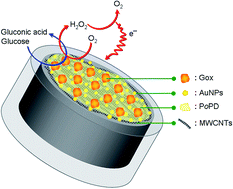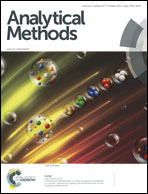A gold nanoparticle functionalized multiwalled carbon nanotube–poly(o-phenylenediamine) composite film for glucose biosensing applications
Abstract
A new biosensor based on immobilization of glucose oxidase on a multiwalled carbon nanotube–gold nanoparticle coated glassy carbon electrode (GCE) was fabricated for the electrochemical determination of glucose. First, a carboxylated multiwalled carbon nanotube (cMWCNT) was functionalized with 4-aminothiophenol (ATP) by a coupling agent, N-(3-dimethylaminopropyl)-N′-ethylcarbodiimide hydrochloride, and then gold nanoparticles (AuNPs) were covalently linked to the ATP–cMWCNT via the formation of a covalent Au–S bond. Finally, glucose oxidase was immobilized simultaneously by the electropolymerization of o-phenylenediamine on the AuNP–ATP–cMWCNT coated GCE. The biosensor showed a linear range from 0.05 mM to 8.85 mM with a sensitivity of 27.93 μA mM−1 cm−2 and a detection limit of 0.015 mM for the detection of glucose. The biosensor was successfully applied to estimate the glucose concentration in human blood serum samples. Furthermore, the AuNP–ATP–cMWCNT was investigated for the non-enzymatic detection of hydrogen peroxide by using voltammetric and amperometric techniques, indicating a linear relationship in the range of 5 × 10−3 to 13.10 mM.


 Please wait while we load your content...
Please wait while we load your content...